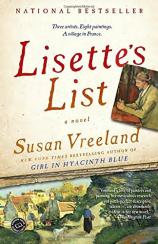Lisette’s List
Review
Lisette’s List
Fiction about art and artists has long been popular. For Van Gogh, see LUST FOR LIFE; for Vermeer, GIRL WITH A PEARL EARRING. Susan Vreeland, author of GIRL IN HYACHINTH BLUE, THE PASSION OF ARTEMISIA and other novels with a painterly theme, is one of its most successful contemporary practitioners. Here, she takes on Post-Impressionism’s heavy hitters, particularly Camille Pissarro and Paul Cézanne. She also offers an evocative twin portrait of Paris and the small southern town of Roussillon.
It is 1937, and a young woman named Lisette Roux comes to Roussillon with her husband, André, to take care of his elderly grandfather, Pascal. Parisian to the core and an aspiring gallery assistant, she is not happy to be plonked down in the middle of the countryside. It is through her citified eyes that we first learn the Provençal terrain, its customs, its landscape, and its prejudices (for example, against uppity women who want to visit the café like their husbands).
It isn’t long, however, before Lisette learns to love her grandfather-in-law, for Pascal is a veritable fount of information about late 19th-century painters, some of whom he knew personally. Originally a miner of ochre in Roussillon, he became a seller of pigments and finally a framer in Paris (he taught André the craft). The old man emphasizes that he was a link in the chain “from mine to majesty”: “I had brought something out of the earth, and it was used to make something beautiful. I was part of a creative process.” Pascal got to know Pissarro and Cézanne, and the most precious things he owns are the seven paintings acquired during his Parisian sojourn (the collection also includes a Picasso!).
Nonetheless, it is a struggle for Lisette to adapt to village life, particularly after World War II begins and André leaves to engage in the vain battle to save France from invasion. She comes to feel at home in Roussillon (“Provence was teaching me to surrender to the seasons, and to wait with patience”); she keeps a goat and a chicken and a vegetable garden, learns to make chèvre and marzipan, shovels waste from under the outhouse, gathers almonds from her tree --- tasks that would have been unimaginable only a few years before. She is a survivor, and I identified very much (as a list maker myself) with the impulse to write down her hopes and intentions.
"I savored Lisette’s journey from Parisian sophisticate to countrywoman, and the way she manages to synthesize her love of art with her affection for Roussillon. Moreover, LISETTE’S LIST has inspired me to revisit the works of these painters at my neighborhood museums."
Lisette makes her list after Pascal dies and André is killed in action. She calls it her List of Hungers and Vows, adding to it as the months and years pass and she finds new challenges. If the title of the list has a spiritual tinge, that makes sense, for Lisette grew up in a Catholic orphanage, and her mentor, Sister Marie Pierre, used to send her out into the streets of Paris, asking her to report back with accurate and detailed accounts of what she observed --- in other words, she taught the girl how to see, which led to Lisette’s fierce interest in art.
One of Lisette’s vows is to recover Pascal’s paintings, which André removed from their frames and hid before he left home. When the occupying Germans confront her, she reveals their hiding place under threat of torture --- but they are no longer there. Who moved them, and where? When the war is over, the search for the paintings, a sort of treasure-hunt through the Provençal landscape, is the main narrative thrust...that, and Lisette’s budding romance with André’s best friend, Maxime, who fought alongside him and watched him die, then was a much abused prisoner-of-war for the duration of the war. Now, he works for a gallery in Paris.
The path to true love, however, is fraught with guilt, trauma, memories and nightmares. Moreover, Lisette has another suitor, the local police constable, Bernard Blanc, an ambiguous character (is he a collaborator or a secret patriot?) who stalks her with gifts (chicken, silk stockings, seeds) and romantic gestures. Ultimately she is torn between “two loves”: the Provençal village and the capital with its enduring allure.
In certain respects, LISETTE’S LIST resembles Vreeland’s previous books, which introduced obscure artists like the 17th-century painter Artemisia Gentileschi, overshadowed by her artist father; Clara Driscoll, a gifted early 20th-century designer who produced, uncredited, much of Louis Comfort Tiffany’s celebrated stained glass; and the pioneering artist Emily Carr, who painted British Columbia and its indigenous peoples in the early 1900s.
However, it’s far more difficult to organize your fiction around better-known artists in a more familiar part of the world. It’s always tricky, in any case, to put real people in novels; the effect is often stilted. LISETTE’S LIST, unfortunately, falls into this trap. Vreeland constantly interrupts her own story with potted histories of art, Provence, the game of boules, the events of wartime…. Pascal’s disquisitions --- it would be fair to call them lectures --- cause the narrative to grind to a halt; similarly, later on, when Lisette and Maxime discuss art, the tone becomes annoyingly didactic.
This problem continues throughout the novel, with Marc Chagall and his wife, Bella, who are hiding in Provence, conveniently putting in an appearance. The couple makes Lisette aware of both the Holocaust and the beginnings of Expressionist art (Chagall doesn’t paint what he sees before him but “what I see inside me”). There is even a cameo role for playwright Samuel Beckett, who lived in Provence for a time during the war (sample dialogue: “I’m writing a play about waiting.” “Just about waiting? That doesn’t sound very interesting”).
Despite these flaws, I savored Lisette’s journey from Parisian sophisticate to countrywoman, and the way she manages to synthesize her love of art with her affection for Roussillon. Moreover, LISETTE’S LIST has inspired me to revisit the works of these painters at my neighborhood museums. Vreeland says in an afterword that she invented two of the works in Pascal’s collection, but the remaining canvases --- as well as others mentioned in the novel, such as Picasso’s Guernica and Cézanne’s The Card Players --- are real. This novel gave me fresh eyes with which to appreciate them.
Reviewed by Kathy Weissman on September 5, 2014
Lisette’s List
- Publication Date: June 23, 2015
- Genres: Fiction, Historical Fiction, Historical Romance, Romance
- Paperback: 448 pages
- Publisher: Random House Trade Paperbacks
- ISBN-10: 0812980190
- ISBN-13: 9780812980196





